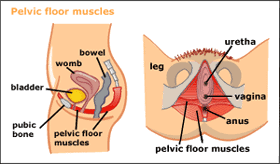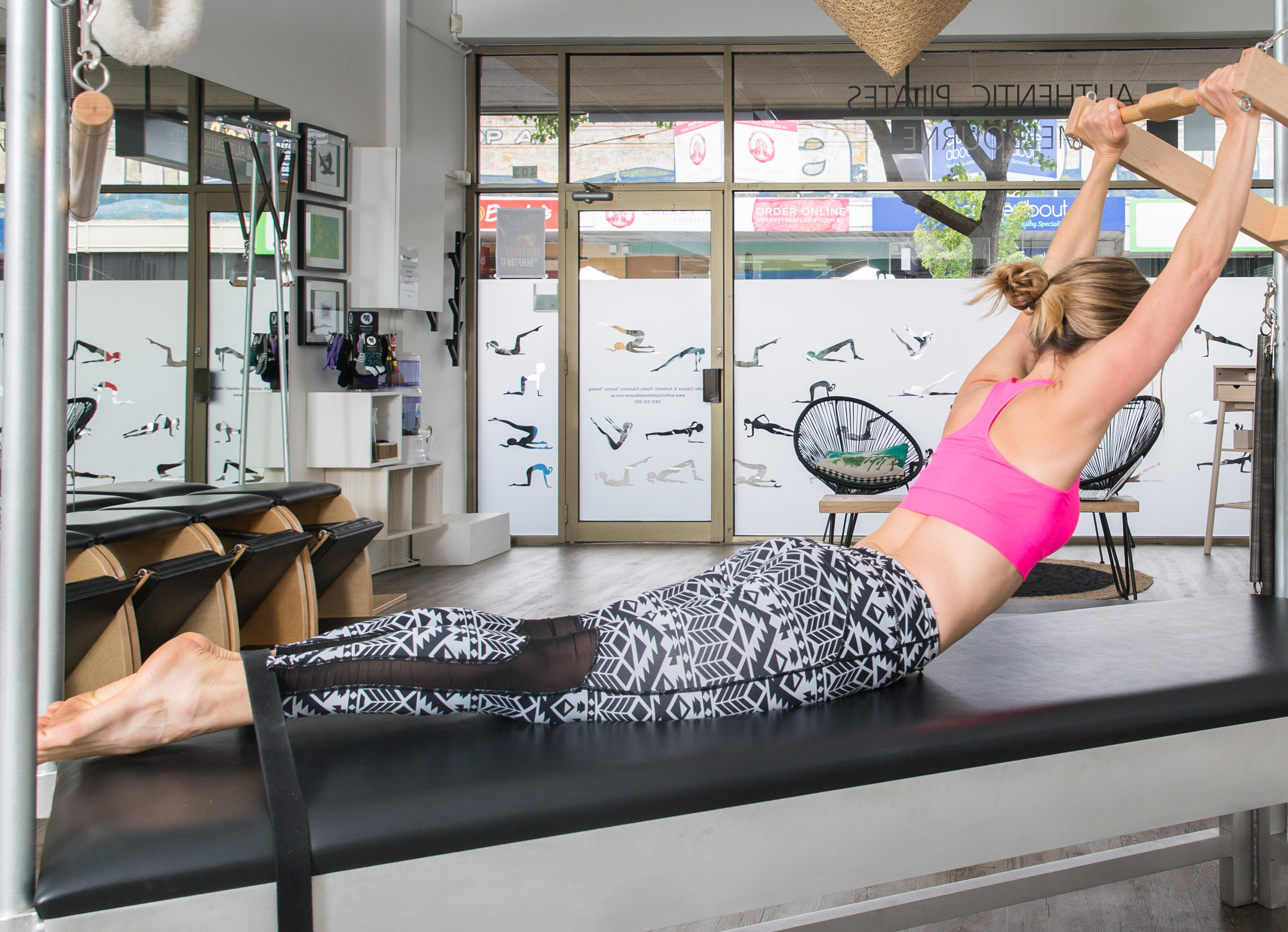My experience with birthing big babies and how Pilates helped my pelvic floor ‘come back’
Ah, the ‘P’ word. Prolapse. More specifically, vaginal prolapse. A word that expectant Mothers fear, and new Mothers don’t want to hear. When the pelvic floor is strong, it supports the pelvic organs to prevent problems such as prolapse. If you’re not familiar with what a prolapse is, emedicinehealth.com define it as ‘a condition in which structures such as the uterus, rectum, bladder, urethra, small bowel or the vagina itself -may begin to prolapse, or fall out of their normal positions’. Yikes. No one wants to imagine their bits hanging between their legs, unless you’re male, in which case, the more hang the better, right?! So, you can imagine my state of disbelief when the Pelvic Floor Women Physio examined me 6 weeks after the birth of my second child and told me I had stage 1 prolapse. Now I knew things were a bit dicey down there, but I didn’t know things were that bad?!
Image courtesy of womenshealthadvice.com
So how does a vaginal prolapse happen?
Damage to the pelvic floor occurs particularly:
1) when there is a long second stage labour (tick- both of my boys),
2) during instrumental deliveries – vacuum extraction or forceps (tick- both of my boys), and
3) in the delivery of large infants (tick- second baby 4.1kilos; Womhealth.org.au).
I guess looking at the history of both births I had a fair chance of a prolapse.
After birth, I distinctly remember having a feeling of detachment - not to my baby, but to my body. It was like my organs and insides were just floating around aimlessly inside my skin, not quite sure what to do, where to be or how to behave, especially my bladder. I was wetting myself for a good week after baby number 2. Highly annoying! Don’t even get me going on having to sneeze or having a laugh at this time. I really had to tune into my bladder, the moment I needed to go to the toilet, there was no waiting, I had to go right then!
I don’t blame you if you’re thinking, ‘but she’s a Pilates teacher, she must do her pelvic floor exercise ALL the time?’ Well yes, and no.
When I was pregnant (and subsequently immediately after birth for the next little while), I would specifically carve out some time in my day to activate my pelvic floor. Usually I was doing a routine, mundane task like, waiting for the kettle to boil in the kitchen or having a shower- anything that happened daily and more than once a day where I would get in the habit of doing them while I waited (more on those specific exercises later).
When I’m not pregnant I don’t really think about my pelvic floor all that much. Sure, I do Pilates and part of doing Pilates is having an awareness of how to engage those muscles in order to stabilise them while another body part is mobilised. But this ‘internal stabilsing’ is something that has become second nature. So, when I do my everyday tasks (e.g., bending down to pick up the many things sprawled across the floor- clothing, toys, mess, towels, animals, children) I first stabilise internally through my pelvic floor, and low abdominals before I mobilise my torso in the direction of the ‘thing’ I’m picking up. Pilates in this way has been a savior. When you can use your pelvic floor and deep abdominals, you are less likely to have low back pain, and I know how inconvenient and restricting back pain is when you have small children who want to be hugged and chased and comforted.
Another important aspect of pelvic floor activation is pelvic floor release. Especially for me, as a Pilates teacher, I’m constantly thinking of drawing ‘in and up’. I do it along with my clients, so, when I’m telling them to do it, I’m unconsciously doing it along with them! If the pelvic floor becomes difficult to relax, it’s constantly in a state of being semi-flexed. Imagine flexing your bicep constantly and never fully letting go, after a while this would cause your arm to lose flexibility, strength and the ability to relax. That is similar to what happens to the pelvic floor (goop.com).
After birth, the body naturally starts to restore and repair. After a week of wetting myself, I could start to hold my bladder slightly longer, after a few weeks, sneezing wasn’t so scary. Still, after the confirmation of stage 1 prolapse at 6 weeks postpartum, I knew there was some further work to do. When I went back to the Pelvic Floor Women Physio at 12 weeks postpartum, I had another internal and was relieved to hear everything was back to ‘normal’.
So what are the actual exercises I did while pregnant and post pregnancy for strengthening and releasing the pelvic floor? Here are 2 simple things that I did:
1. Sitting down with a pillow or folded up towel between the bottom of your inside thighs, sit yourself towards the edge of the couch or chair (no kickin’ back in a slump!). Feet flat on the ground, lift up tall out of your pelvis up to the top of your head. Take an inhale breath to prepare, then on the exhale breath, gently squeeze the pillow or towel while thinking about stopping a wee mid-stream as well as holding in a fart. This will lift the hammock of muscles at the base of the pelvic floor from your front passage to the back passage in and upwards. Try and hold for 5 seconds (you can build up to 10, 15, 20, 30 secs etc.). Make sure that when you let go, you feel a proper distinction between the contraction and the release. If you feel like you couldn’t distinguish between holding the pelvic floor up and letting it go, try reducing the amount of time you hold on for. I was starting at about 3 sets and worked up to around 8-10.
Image unknown
2. Standing up, slightly bent over (kitchen bench is usually a good option), with your legs hip width apart (it’s harder to squeeze your glutes together in this position so you have a better chance of isolating the pelvic floor muscles), draw up and in through the pelvic floor when you exhale (remember, this should feel like you are holding a wee and fart). I often put my hand on my low tummy when doing this. You want to feel that your low tummy is pulling away from your hand towards your spine. Repetitions and durations are the same as the sitting variation.
A couple of pointers to be aware of:
· Don’t hold your breath. Breathe normally over the contraction of the pelvic floor muscles,
· Don’t squeeze your bum cheeks together (can be tricky to isolate pelvic floor and the surrounding muscles- if you find it hard to switch off the glutes try the version standing up), and
· Tune in to your shoulders- make sure they don’t creep up to your ears and start overworking.
Image courtesy of @neetaphotography on location at Authentic Pilates Melbourne, Hampton, Melbourne.
Upon reflection, I think the odds were always going to be against me given my birth scenarios, regardless of my job and pelvic floor abilities! However, I’d hate to think what state my insides might be in without the exercises I did during and after pregnancy… who knows?!
I credit Pilates as setting the baseline of my fitness and strength before I fell pregnant. Being attune to my body allowed me to work safely through exercise to maintain my strength and flexibility while I was pregnant, making the road back from the birth of my boys not as daunting as I initially expected.
I recently made this little video demonstrating the sitting down pelvic floor exercises. In the video I’m using a Pilates Magic Circle, however, a rolled-up towel or cushion would be fine.
For those of you interested in starting Pilates prior to, during or after your pregnancy in the comfort of your own home check out my website for more information and contact details.
Please note: This is not intended to be specific advice; pelvic floor muscle training is not necessarily one-size fits all. I recommend being evaluated by a pelvic floor specialist if you are experiencing difficulties.
You should also be sure to gain clearance from your Obstetrician/GP after the birth of your baby before you undertake/begin any exercise.






